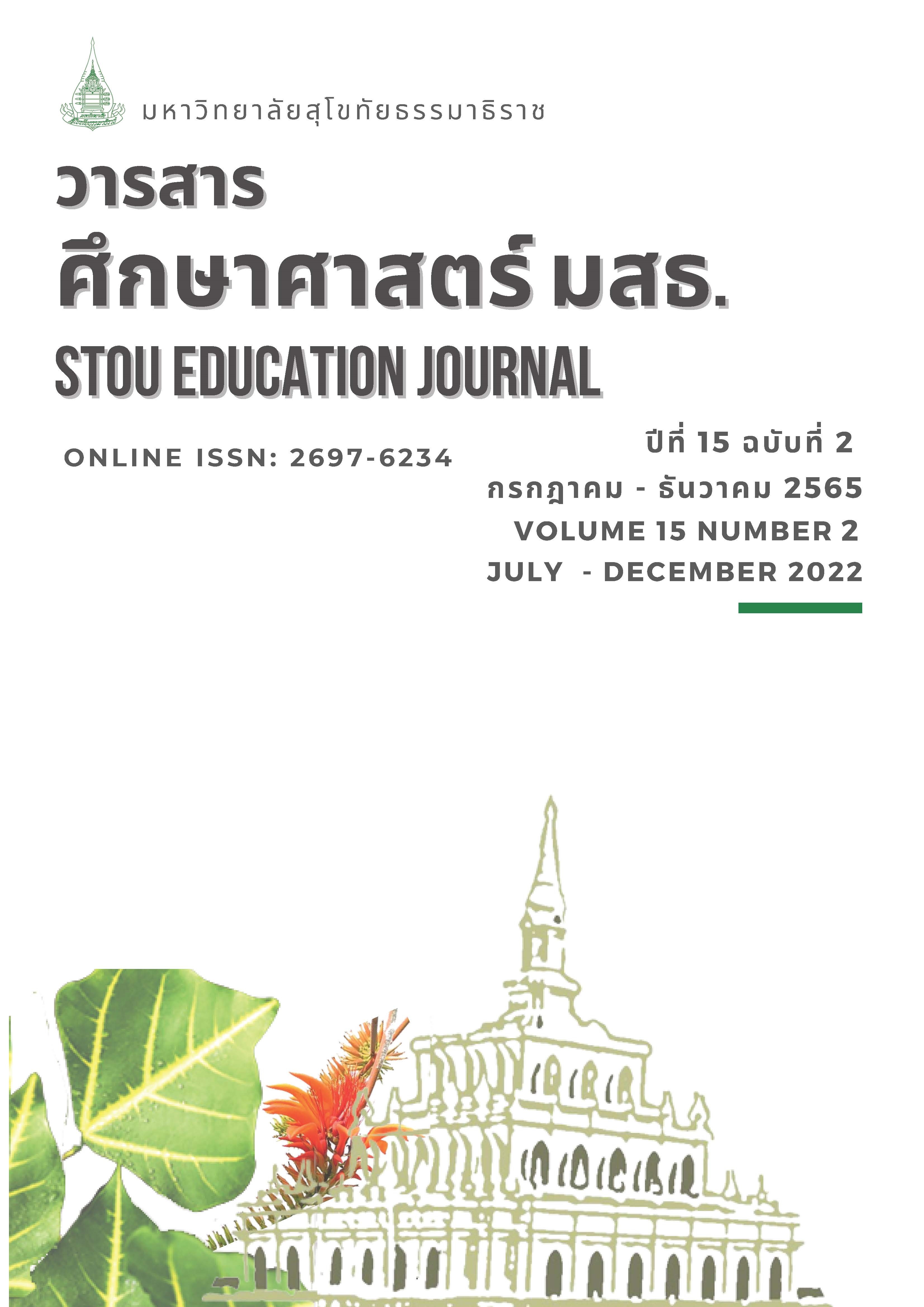Academic Management Innovation Creating STEM Education Innovators for Application in Real Life Situations
Main Article Content
Abstract
The objective of this study was to develop an academic management innovation creating STEM Education innovators of secondary schools based on the concept of real life applications of STEM education. This study was a multi-phase mixed method research. The research sample included a total of 296 secondary schools under the Office of the Basic Education Commission out of the population of 2,358 schools. The key informants were divided into 3 groups, namely, school administrators, heads of academic administration group, and teachers teaching the STEM education courses in secondary schools under the Office of the Basic Education Commission, all of whom were obtained by multi-stage random sampling of schools and informants. The tools used in research were a questionnaire on current conditions and desirable conditions of academic administration based on the concept of applying STEM education in real life, and a scale for assessment of the feasibility and suitability of the academic management innovation of secondary schools based on the concept of real life applications of STEM education. Data were analyzed by using the frequency, percentage, mean, standard deviation, Priority Needs Index Modified (PNImodified) and content analysis. The academic management innovation draft No.1 was synthesized. Then the feasibility and suitability of academic administration innovation draft No.1 were evaluated by 17 experts. After that, the first draft was adjusted to become the academic administration innovation draft No. 2. Then the feasibility and suitability of the draft No. 2 were evaluated by 9 experts in the focus group discussion to adjust and draft the complete academic administration innovation. The research findings showed that the academic management innovation to create STEM innovators for real life application was composed of 3 main components: (1) curriculum innovation creating STEM innovators to solve life, work and economic problems; (2) instructional innovation creating STEM innovators to solve life, work and economic problems; and (3) measurement and evaluation innovation creating STEM innovators to solve life, work and economic problems.
Article Details
References
ณิชภัทร นนทะโส และยุทธพงศ์ ทิพย์ชาติ. (2561). การศึกษาสภาพการจัดการเรียนรู้แบบสะเต็มศึกษาตามความคิดเห็นของครูในสังกัดสำนักงานเขตพื้นที่การศึกษาประถมศึกษาชัยภูมิเขต 2. การประชุมวิชาการและนำเสนอผลงานวิจัยระดับชาติ ราชธานีวิชาการ ครั้งที่3, 1447-1460.
นุชนภา ราชนิยม. (2554). การศึกษาสภาพปัญหา และความพร้อมของการจัดการเรียนการสอนรูปแบบสะเต็มศึกษาในระดับประถมศึกษา กรุงเทพมหานคร. [วิทยานิพนธ์ปริญญามหาบัณฑิต ไม่ได้ตีพิมพ์]. จุฬาลงกรณ์มหาวิทยาลัย. CUIR. http://cuir.car.chula.ac.th/handle/123456789/51059
บำรุง เฉียบแหลม. (2559). นโยบายการจัดการเรียนการสอนสะเต็มในสถานศึกษา. สระบุรี. รายงานผลการติดตามและประเมินผลการดำเนินงานของสำนักงานศึกษาธิการจังหวัด ในเขตตรวจราชการที่ 1. กระทรวงศึกษาธิการ. http://www.reo1.moe.go.th/web/images/download/2560-reo1-policy-stem.pdf
ประสงค์สิทธิ์ ราชชมภู และนิธิตา สิริพงศ์ทักษิณ. (2563). กระบวนการนำนโยบายสะเต็มศึกษาไปปฏิบัติในโรงเรียนสังกัดกรุงเทพมหานคร. วารสารการบริหารการปกครอง, 9(2), 541-556.
ปูชนีย์ ช่วยไธสง และพีรศักดิ์ วรฉัตร. (2563). การพัฒนาแนวทางการบริหารสะเต็มศึกษาในสถานศึกษาสังกัดสำนักงานเขตพื้นที่มัธยมศึกษา เขต 32. วารสารมหาวิทยาลัยมหามกุฏราชวิทยาลัย วิทยาเขตร้อยเอ็ด, 9(2), 584-597.
พฤทธิ์ ศิริบรรณพิทักษ์. (2561). บทบรรณาธิการ. วารสารการบริหารและนวัตกรรมการศึกษา, 1(2).
ลือชา ลดาชาติ, วิลาวัลย์ โพธิ์ทอง, วิไลภรณ์ ฤทธิคุปต์ และลฏาภา ลดาชาติ. (2562). ความเข้าใจและมุมมองของครูเกี่ยวกับสะเต็มศึกษาและการออกแบบเชิงวิศวกรรม. วารสารมหาวิทยาลัยศิลปากร, 39(3), 133-149.
วิทยา วรพันธุ์ และ ประสาท เนืองเฉลิม. (2562). การประเมินการเรียนรู้ตามแนวทางสะเต็มศึกษา. วารสารสถาบันวิจัยและพัฒนา มหาวิทยาลัยราชภัฏมหาสารคาม, 6(1), 419-426.
สถาบันส่งเสริมการสอนวิทยาศาสตร์และเทคโนโลยี. (2561, 2 กันยายน). รู้จักสะเต็ม. STEM education Thailand. http://www.stemedthailand.org/?page_id=23
สำนักงานคณะกรรมการการศึกษาขั้นพื้นฐาน. (2563). นโยบายสำนักงานคณะกรรมการการศึกษาขั้นพื้นฐาน ปีงบประมาณ 2563. สำนักงานคณะกรรมการการศึกษาขั้นพื้นฐาน.
สำนักเลขาธิการสภาการศึกษา. (2559). รายงานการวิจัย เพื่อจัดทำข้อเสนอนโยบาย การส่งเสริมการจัดการศึกษาด้านสะเต็มศึกษาของประเทศไทย. สำนักงานเลขาธิการสภาการศึกษา.
สำนักเลขาธิการสภาการศึกษา. (2559). รายงานการวิจัยแนวโน้มภาพอนาคตการศึกษาและการเรียนรู้ของไทยในปีพ.ศ.2573. สำนักงานเลขาธิการสภาการศึกษา.
สำนักงานเลขาธิการสภาการศึกษา. (2562). มาตรฐานการศึกษาของชาติ พ.ศ.2561. สำนักงานเลขาธิการสภาการศึกษา.
Beatty, A. (2011). Successful STEM education:workshop summary. The National Academies Press.
Homhol, P.D. & Kanjanasakda, Y. (2009). Need for and lack of engineering workforce in Thailand’s industrail estates. University of Thai Chamber of Commerce Journal, 29(3),67-83.
Markman, A. (2012, December 4). How to create an innovation ecosystem. Harvard Business Review. https://hbr.org/2012/12/how-to-create-an-innovation-ec
Painprasert, N. & Jeerungsuwan, N. (2015). Factors supporting the STEM education learning management of leader teachers in the STEM education network of Thailand. The Twelfeth International Conference on eLearning for Knowledge-Based Society (pp. 36.1-36.6). Siam Technology College.
Vasquez Jo.A., Sneiser, C.I., & Comer, M. W. (2013). STEM Lesson essentials, grade3-8: Integrating science, technology, engineering, and mathematics. Heinemann.
Vennix, J., den Brok, P. & Taconis, R. . (2017). Perceptions of STEM-based outreach learning activities in secondary education. Learning Environment Research, 20(1), 21-46. https://doi.org/10.1007/s10984-016-9217-6


